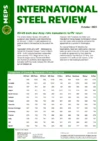Port strikes could disrupt 30% of US steel imports
Potential strike action at ports on the United States’ East and Gulf Coasts could disrupt over 30% of the countries’ overseas imports and add to importers’ transport costs.
The current union agreement between the International Longshoreman’s Association (ILA) and the United States Maritime Alliance (USMX) expires on September 30. This covers over 45,000 port workers at the Gulf and East Coast ports. The ILA has repeatedly said that they will not extend the expiry date and are prepared to strike in early October.
A strike would shut down the flow of goods in and out of the US at more than 40 ports along the East and Gulf Coast and would impact trade in the rest of the country.
In 2023, imported material accounted for 26% of US apparent steel consumption. Based upon the origin of US steel imports, MEPS International has estimated that more than 30% of steel imports enter through an East or Gulf Coast port.
Importers are already taking action to mitigate the effects of a possible strike. Laura Hodges, a US steel analyst at MEPS International, said: "West Coast ports have recently seen a strong import increase from Asia, partially due to the possible ILA strike. Importers are front-loading goods ahead of the busy holiday season and redirecting shipments from the East Coast.”
Complex negotiations
The ILA union is targeting a wage increase of over 32% on an agreement reached with the West Coast International Longshore and Warehouse Union (ILWU) in June last year. It has also said that wages need to be aligned with carriers’ profits during the pandemic. Furthermore, the union intends to continue its fight against automation and expand the role of longshoremen at US ports.
The West Coast’s ILWU agreed its new six-year agreement with the port terminals and ocean carriers last summer. However, the negotiation stretched 13 months past the deadline and involved assistance from Acting US Secretary of Labor Julie Su.
These agreements are typically time-consuming given the need to negotiate at a local and master contract level, with multiple parties involved. The ILA targeted May 17 as the date to finish negotiations at the local level. The union cut off talks with USMX in June after accusing port operators of violating the automation clause in the current agreement at multiple ports.
Who would be most affected by a strike?
Steel suppliers in Canada and Mexico are two of the largest exporters to the US, representing 39% of steel imports in 2023, and are unlikely to use ocean ports to transport material.
In the first half of 2024, Brazil was the second largest US importer, delivering almost 2.3 million tonnes according to the US Census Bureau. Slabs represented more than 80% of those imports.
By tonnage, the Port of Houston is the largest of the East Coast’s port facilities. According to 2022 data from the US Army Corp of Engineers, it is the sixth largest container port in the US. Last year more than 4.5 million short tons of steel flowed through the facility (both imports and exports).
Given the growing risk of a strike in October, US importers will now be considering actions to mitigate their potential negative effects, in their near-term planning.
- MEPS International delivers monthly price data and commentary from the US steel market in its International Steel Review publication. Contact MEPS for details of the report and how to subscribe.

Source:
International Steel Review
The MEPS International Steel Review is an essential monthly publication, offering professional analysis and insight into carbon steel prices around the world.
Go to productRequest a free publication






